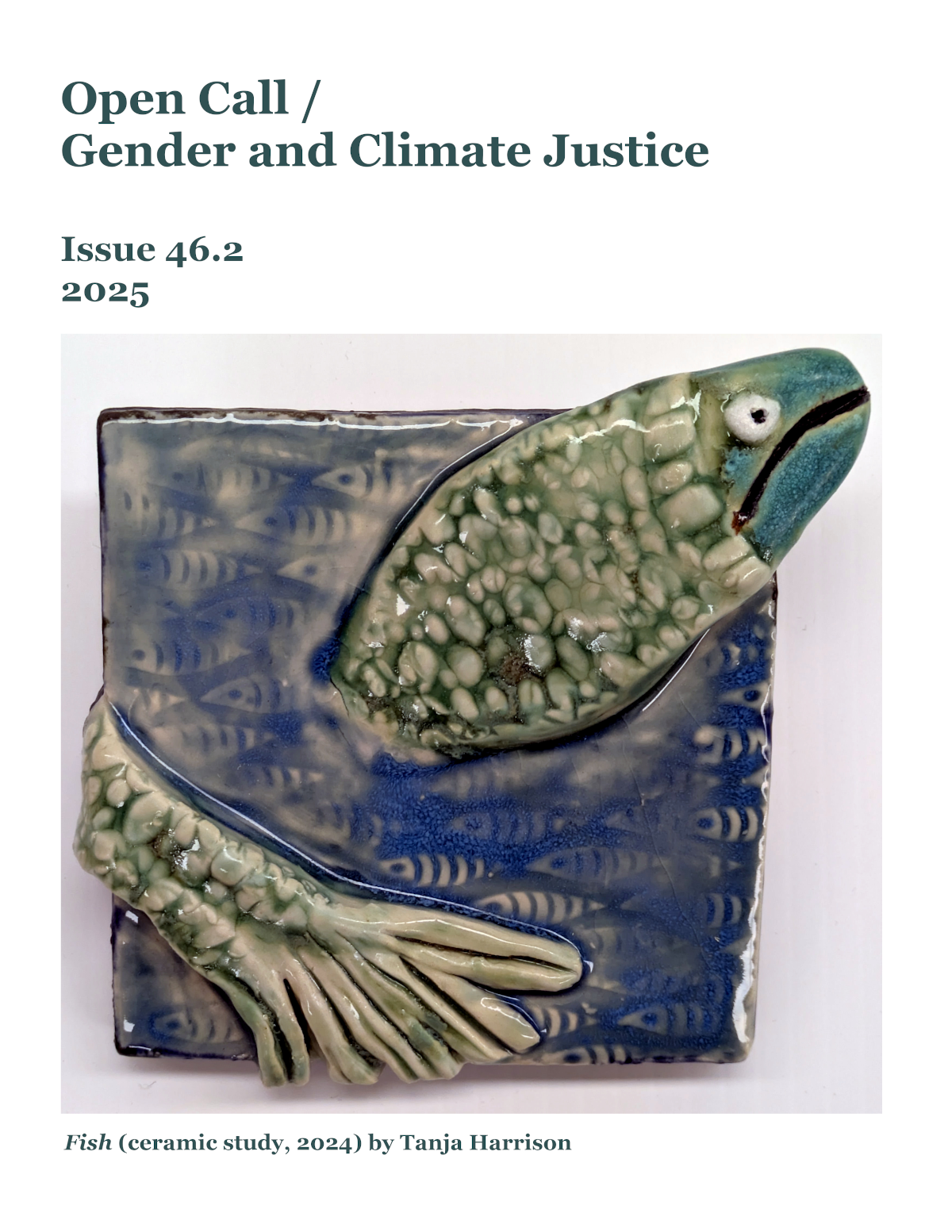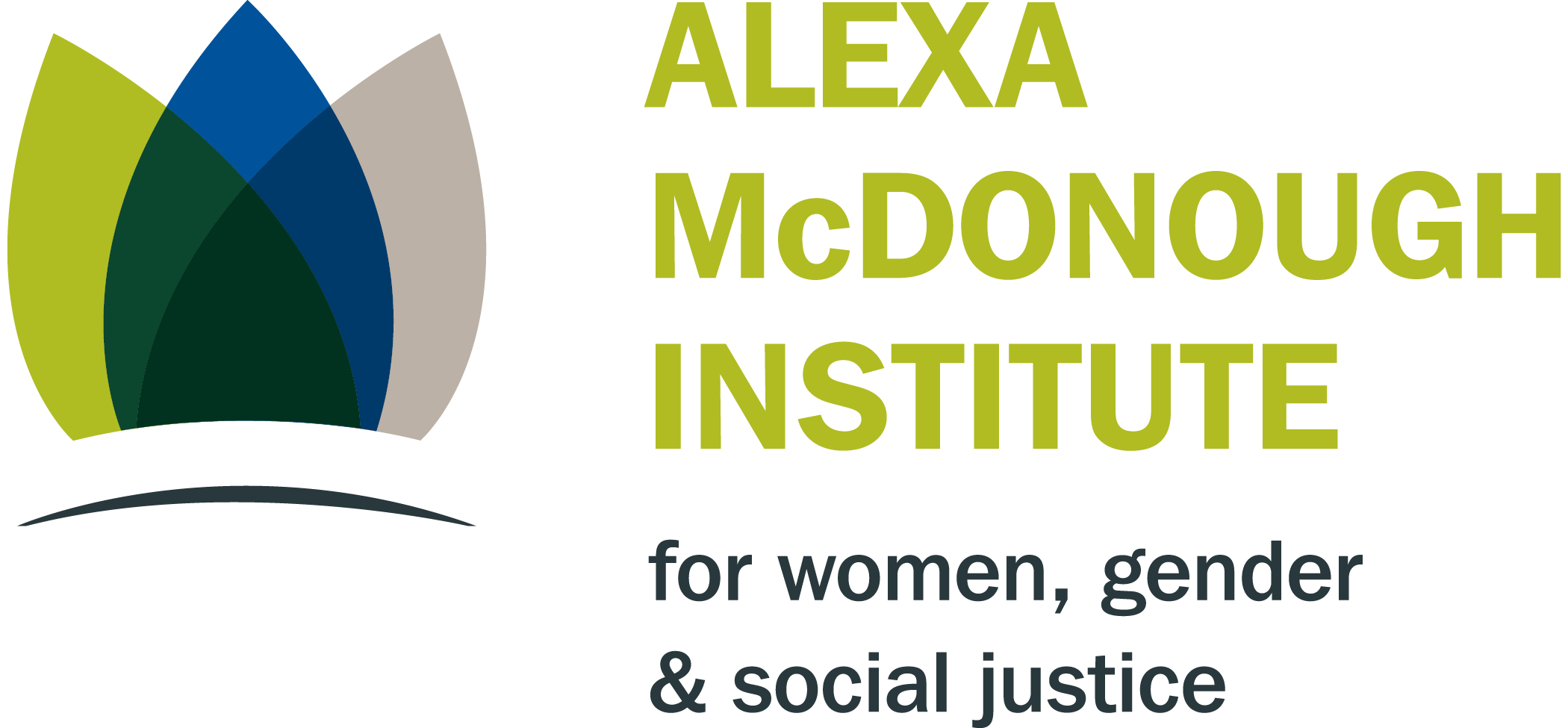Intersectional Promises
How Well did the Canadian National Action Plan to End Gender-Based Violence Integrate an Intersectional Approach?
Keywords:
intersectionality, content analysis, gender-based violence, IBPA, policy analysisAbstract
It took more than ten years of feminist advocacy for the Canadian government to adopt the National Action Plan (NAP) to End Gender-Based Violence (GBV) on November 9, 2022. This study is among the first to trace the development of and critique the NAP. Specifically, I interrogate how well is the NAP grounded in an intersectional approach. Using the adjusted Intersectionality-Based Policy Analysis (IBPA) and qualitative content analysis as research methods, I argue that the recently adopted NAP is premised on a deflated definition of intersectionality and lacks attention to the role of existing policies in reproducing social inequalities. The NAP fails to centre the voices of those most affected and to demonstrate an in-depth understanding of systemic causes and effects of GBV resulting in different intersectional needs of various at-risk groups. As a consequence, the NAP provides symbolically intersectional solutions that are unlikely to be effective in addressing GBV. In addition, the NAP relies on non-intersectional data for progress assessment, and it is without built-in mechanisms for meaningful engagement of the most affected groups. With such a design, the current NAP will not be able to achieve the stated vision of a Canada free from GBV.
References
Ahmed, Sara. 2016. “How Not to do Things with Words.” Wagadu: A Journal of Transnational Women’s and Gender Studies 16: 1-10.
_____. 2018. “Rocking the Boat: Women of Color as Diversity Workers.” In Dismantling Race In Higher Education: Racism, Whiteness and Decolonising the Academy edited by Jason Arday and Heidi Safia Mirza, 331-348. Cham: Springer International Publishing. doi.org/10.1007/978-3-319-60261-5
Altheide, David L., and Christopher J. Schneider. 2013. Qualitative Media Analysis. Second Edition, 55 City Road, London: SAGE Publications Ltd. https://doi.org/10.4135/9781452270043.
Bilge, Sirma. 2012. “Intersectionality Undone: Saving Intersectionality from Feminist Intersectionality Studies.” Du Bois Review: Social Science Research on Race 10(2):405–24. doi.org/10.1017/S1742058X13000283.
Bowleg, Lisa. 2008. “When Black + Lesbian + Woman ≠ Black Lesbian Woman: The Methodological Challenges of Qualitative and Quantitative Intersectionality Research.” Sex Roles 59(5-6): 312–25. doi.org/10.1007/s11199-008-9400-z.
_____ 2012. “The Problem With the Phrase Women and Minorities: Intersectionality—an Important Theoretical Framework for Public Health.” American Journal of Public Health 102(7): 1267–73. doi.org/10.2105/AJPH.2012.300750.
Carastathis, Anna. 2016. Intersectionality: Origins, Contestations, Horizons. University of Nebraska Press. https://doi.org/10.2307/j.ctt1fzhfz8.
Carbado, Devon W. and Cheryl I. Harris. 2019. “Intersectionality At 30: Mapping The Margins Of Anti-Essentialism, Intersectionality, And Dominance Theory.” Harvard Law Review 132:2193
Cho, Sumi, Kimberlé Williams Crenshaw, and Leslie McCall. 2013. “Toward a Field of Intersectionality Studies: Theory, Applications, and Praxis.” Signs: Journal of Women in Culture and Society 38(4): 785–810. doi.org/10.1086/669608.
Christoffersen, Ashlee. 2023. “Applying Intersectionality in Policy and Practice: Unseating the Dominance of Gender in Responding to Social Inequalities.” Sozialpolitik.Ch 1(1-13). https://doi.org/10.18753/2297-8224-4030.
Cole, Elizabeth R., and Lauren E. Duncan. 2023. “Better Policy Interventions through Intersectionality.” Social Issues and Policy Review 17(1): 62–78. doi.org/10.1111/sipr.12090.
Collins, Patricia Hill. 2015. “Intersectionality’s Definitional Dilemmas.” Annual Review of Sociology 41(1): 1–20. doi.org/10.1146/annurev-soc-073014-112142.
Collins, Patricia Hill and Sirma Bilge. 2020. Intersectionality, 2nd Edition. Polity Press.
Crenshaw Kimberlé W. 1989. “Demarginalizing the Intersection of Race and Sex: A Black Feminist Critique of Antidiscrimination Doctrine, Feminist Theory and Antiracist Politics.” University of Chicago Legal Forum 139-168
_____. 1991. “Mapping the Margins: Intersectionality, Identity Politics, and Violence against Women of Color.” Stanford Law Review 43(6): 1241-1299 https://www.jstor.org/stable/1229039
Dale, Amanda, Krys Maki, and Rotbah Nitia. 2021. Roadmap for the National Action Plan on Violence Against Women and Gender-Based Violence. A Report to Guide the Implementation of a National Action Plan on Violence Against Women and Gender-Based Violence. Women’s Shelters Canada Ottawa, ON. https://nationalactionplan.ca/#_thereport
Day, Aviah Sarah and Aisha K Gill. 2020. “Applying intersectionality to partnerships between women’s organizations and the criminal justice system in relation to domestic violence.” British Journal of Criminology 60: 830-850. doi.org/10.1093/bjc/azaa003
Di Matteo, Claudia. 2022. “The Institutionalization of Gender-Based Violence (GBV) and Migrant Women’s Access to Social Protection System in Advanced Welfare Societies.” About Gender: International Journal of Gender Studies 11(22): 66-108. doi.org/10.15167/2279-5057/AG2022.11.22.2032
Dubrow, Joshua K., and Corina Ilinca. 2019. “Quantitative Approaches to Intersectionality: New Methodological Directions and Implications for Policy Analysis.” In The Palgrave Handbook of Intersectionality in Public Policy, edited by Olena Hankivsky and Julia S. Jordan-Zachery, 195–214. The Politics of Intersectionality. Cham: Springer International Publishing. doi.org/10.1007/978-3-319-98473-5_8.
Garcia, Teresa C., and Anna Zajicek. 2022. “Incorporating Intersectionality in Public Policy: A Systematic Literature Review.” Humanity & Society 46(2): 271–90. doi.org/10.1177/0160597620988591.
Gotell, Lise. 2023. “Policy Discourses on Sexual Violence: From the Royal Commission to the (Post-) Neoliberal State.” In Feminism’s Fight: Challenging Politics and Policies in Canada since 1970 edited by Barbara Cameron and Meg Luxton, 153-176. University of British Columbia Press. doi.org/10.59962/9780774868051-007
Gopaldas, Ahir. 2013. “Intersectionality 101.” Journal of Public Policy and Marketing 32: 90–94. doi.org/10.1509/jppm.12.044
Grace, Daniel. 2014. Intersectionality-Informed Mixed Methods Research: A Primer. The Institute for Intersectionality Research & Policy, SFU. https://www.ktpathways.ca/resources/intersectionality-informed-mixed-methods-research-primer
Grand’Maison, Valérie. 2024. “Resisting Invisibility in Healthcare Responses to Gender-based Violence: A Content Analysis.” Health Sociology Review 33(2): 144-159 doi.org/10.1080/14461242.2024.2350510
Grant, Tavia, Molly Hayes and Elizabeth Renzetti. 2022. “Where is Canada’s national action plan to end gender-based violence?” The Globe and Mail. May 25. https://www.theglobeandmail.com/canada/article-where-is-canadas-national-action-plan-to-end-gender-based-violence/
Hankivsky, Olena (Ed.) 2012. An Intersectionality-Based Policy Analysis Framework. Vancouver, BC: Institute for Intersectionality Research and Policy, Simon Fraser University.
Hankivsky, Olena, and Renee Cormier. 2011. Intersectionality and Public Policy: Some Lessons from Existing Models. Political Research Quarterly 64(1): 217–229 doi: 10.1177/1065912910376385
Hankivsky, Olena, and Julia S. Jordan-Zachery. 2019. “Introduction: Bringing Intersectionality to Public Policy.” In The Palgrave Handbook of Intersectionality in Public Policy, edited by Olena Hankivsky and Julia S. Jordan-Zachery, 1–28. The Politics of Intersectionality. Cham: Springer International Publishing. doi.org/10.1007/978-3-319-98473-5_1.
Henriksen, Lena, Sezer Kisa, Mirjam Lukasse, Eva Marie Flaathen, Berit Mortensen, Elisabeth Karlsen, and Lisa Garnweidner-Holme. 2023. “Cultural Sensitivity in Interventions Aiming to Reduce or Prevent Intimate Partner Violence During Pregnancy: A Scoping Review.” Trauma, Violence, and Abuse 24(1): 97–109. doi.org/10.1177/15248380211021788.
Jackson, Jessi Lee. 2018. “The Non-Performativity of Implicit Bias Training.” Radical Teacher: A Socialist, Feminist, and Anti-Racist Journal on the Theory and Practice of Teaching, 112: 46-54. doi.org/10.5195/rt.2018.497.
“Joint Statement on the Release of the National Action Plan to End Gender-Based Violence.” 2023. End Violence Against Women | Women’s Shelters Canada, March 17. https://endvaw.ca/archives/news/joint-statement-on-the-release-of-the-national-action-plan-to-end-gender-based-violence/
Krippendorff, Klaus. 2019. Content Analysis: An Introduction to Its Methodology. Fourth Edition, Thousand Oaks, CA: SAGE Publications, Inc. doi.org/10.4135/9781071878781.
LaMartine, Samantha, Nadine Nakamura, and James J. García. 2023. “‘Even the Officers Are in on It:’ Black Transgender Women’s Experiences of Violence and Victimization in Los Angeles.” Women and Therapy 46(2): 103–29. doi:10.1080/02703149.2023.2226012.
Manning, Susan M., and Leah Levac. 2022. “The Canadian Impact Assessment Act and Intersectional Analysis: Exaggerated Tensions, Fierce Resistance, Little Understanding.” Canadian Public Administration 65(2): 242–60. doi.org/10.1111/capa.12458.
Mirza, Heidi Safia. 2022. “‘A Vindication of the Rights of Black Women’: Black British Feminism Then and Now.” In The Palgrave Handbook of Critical Race and Gender, edited by Shirley Anne Tate and Encarnación Gutiérrez Rodríguez, 189–207. Cham: Springer International Publishing. https://doi.org/10.1007/978-3-030-83947-5_10.
Nash, Jennifer. 2019. “CODA.: Some of Us Are Tired.” In Black Feminism Reimagined: After Intersectionality, 133–38. Duke University Press. https://doi.org/10.2307/j.ctv111jhd0.9.
Roberts, Dorothy, and Sujatha Jesudason. 2013. “Movement Intersectionality: The Case of Race, Gender, Disability, and Genetic Technologies.” Du Bois Review: Social Science Research on Race 10(2): 313–28. doi.org/10.1017/S1742058X13000210.
Rezai-Rashti, Goli, Bailing Zhang, Shirin Abdmolaei, Allison Segeren. 2021. A Critical Policy Analysis of the Ontario Equity and Inclusive Strategy: The Dynamics of Non-Performativity. johepal. 2(4), 7-25. doi:10.52547/johepal.2.4.7
Tate, Shirley Anne. 2022. From Post-Intersectionality to Black Decolonial Feminism: Black Skin Affections (1st ed.). Routledge. doi.org/10.4324/b23223
Walby, S., J. Armstrong, and S. Strid. 2012. “Intersectionality and the Quality of the Gender Equality Architecture.” Social Politics: International Studies in Gender, State & Society 19(4): 446–81. doi.org/10.1093/sp/jxs015.
WAGE (Women and Gender Equality Canada). 2022a. National Action Plan to End Gender-Based Violence Backgrounder. Accessed November 12, 2024. https://www.canada.ca/en/women-gender-equality/news/2022/11/national-action-plan-to-end-gender-based-violence-backgrounder.html
WAGE (Women and Gender Equality Canada). 2022b. “National Action Plan to End Gender-Based Violence.” Government of Canada. Accessed December 23, 2023. https://www.canada.ca/en/women-gender-equality/gender-based-violence/intergovernmental-collaboration/national-action-plan-end-gender-based-violence/first-national-action-plan-end-gender-based-violence.html
Downloads
Published
Issue
Section
License
Copyright (c) 2025 Olesya Kochkina

This work is licensed under a Creative Commons Attribution 4.0 International License.
Authors who publish with this journal agree to the following terms:
1. Authors retain copyright and grant the journal right of first publication, with the work simultaneously licensed under a Creative Commons Attribution 4.0 International License that allows others to share the work with an acknowledgement of the work's authorship and initial publication in this journal.
2. Authors are aware that articles published in Atlantis are indexed and made available through various scholarly and professional search tools, including but not limited to Erudit.
3. Authors are able to enter into separate, additional contractual arrangements for the non-exclusive distribution of the journal's published version of the work (e.g., post it to an institutional repository or publish it in a book), with an acknowledgement of its initial publication in this journal.
4. Authors are permitted and encouraged to preprint their work, that is, post their work online (e.g., in institutional repositories or on their website) prior to and during the submission process. This can lead to productive exchanges, as well as earlier and greater citation of published work. Read more on preprints here.







